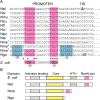Sigma factor RpoN (σ54) regulates pilE transcription in commensal Neisseria elongata
- PMID: 23899162
- PMCID: PMC4474139
- DOI: 10.1111/mmi.12350
Sigma factor RpoN (σ54) regulates pilE transcription in commensal Neisseria elongata
Abstract
Human-adapted Neisseria includes two pathogens, Neisseria gonorrhoeae and Neisseria meningitidis, and at least 13 species of commensals that colonize many of the same niches as the pathogens. The Type IV pilus plays an important role in the biology of pathogenic Neisseria. In these species, Sigma factor RpoD (σ(70)), Integration Host Factor, and repressors RegF and CrgA regulate transcription of pilE, the gene encoding the pilus structural subunit. The Type IV pilus is also a strictly conserved trait in commensal Neisseria. We present evidence that a different mechanism regulates pilE transcription in commensals. Using Neisseria elongata as a model, we show that Sigma factor RpoN (σ(54)), Integration Host Factor, and an activator we name Npa regulate pilE transcription. Taken in context with previous reports, our findings indicate pilE regulation switched from an RpoN- to an RpoD-dependent mechanism as pathogenic Neisseria diverged from commensals during evolution. Our findings have implications for the timing of Tfp expression and Tfp-mediated host cell interactions in these two groups of bacteria.
© 2013 John Wiley & Sons Ltd.
Figures






Similar articles
-
Contribution of σ70 and σN Factors to Expression of Class II pilE in Neisseria meningitidis.J Bacteriol. 2019 Sep 20;201(20):e00170-19. doi: 10.1128/JB.00170-19. Print 2019 Oct 15. J Bacteriol. 2019. PMID: 31331980 Free PMC article.
-
RpoN and the Nps and Npa two-component regulatory system control pilE transcription in commensal Neisseria.Microbiologyopen. 2019 May;8(5):e00713. doi: 10.1002/mbo3.713. Epub 2018 Aug 5. Microbiologyopen. 2019. PMID: 30079633 Free PMC article.
-
Transcriptional control of gonococcal pilE expression: involvement of an alternate sigma factor.Gene. 1993 Dec 31;137(2):233-6. doi: 10.1016/0378-1119(93)90012-r. Gene. 1993. PMID: 8299953
-
The Regulatory Functions of σ54 Factor in Phytopathogenic Bacteria.Int J Mol Sci. 2021 Nov 24;22(23):12692. doi: 10.3390/ijms222312692. Int J Mol Sci. 2021. PMID: 34884502 Free PMC article. Review.
-
Bacterial enhancer-binding proteins: unlocking sigma54-dependent gene transcription.Curr Opin Struct Biol. 2007 Feb;17(1):110-6. doi: 10.1016/j.sbi.2006.11.002. Epub 2006 Dec 6. Curr Opin Struct Biol. 2007. PMID: 17157497 Review.
Cited by
-
Sigma factor RpoN employs a dual transcriptional regulation for controlling twitching motility and biofilm formation in Lysobacter enzymogenes OH11.Curr Genet. 2018 Apr;64(2):515-527. doi: 10.1007/s00294-017-0770-z. Epub 2017 Oct 24. Curr Genet. 2018. PMID: 29067482
-
Type IV pilin regulation: a transcriptional overview.Crit Rev Microbiol. 2025 Jun 20:1-28. doi: 10.1080/1040841X.2025.2520778. Online ahead of print. Crit Rev Microbiol. 2025. PMID: 40539451 Review.
-
Contribution of σ70 and σN Factors to Expression of Class II pilE in Neisseria meningitidis.J Bacteriol. 2019 Sep 20;201(20):e00170-19. doi: 10.1128/JB.00170-19. Print 2019 Oct 15. J Bacteriol. 2019. PMID: 31331980 Free PMC article.
-
Neisseria elongata subsp elongata infective endocarditis following endurance exercise.BMJ Case Rep. 2015 Dec 11;2015:bcr2015212415. doi: 10.1136/bcr-2015-212415. BMJ Case Rep. 2015. PMID: 26655669 Free PMC article.
-
Genome-wide screen identifies host colonization determinants in a bacterial gut symbiont.Proc Natl Acad Sci U S A. 2016 Nov 29;113(48):13887-13892. doi: 10.1073/pnas.1610856113. Epub 2016 Nov 14. Proc Natl Acad Sci U S A. 2016. PMID: 27849596 Free PMC article.
References
-
- Boyle-Vavra S, So M, Seifert HS. Transcriptional control of gonococcal pilE expression: involvement of an alternate sigma factor. Gene. 1993;137:233–236. - PubMed
Publication types
MeSH terms
Substances
Grants and funding
LinkOut - more resources
Full Text Sources
Other Literature Sources

